
Your Agave’s Blooming–Now What?
What should you do when your agaves bloom? In my new video, and in the Q&A and photo gallery here, you'll find expert advice, cautions, 20+ agaves in bloom (all ID'd), and how to start new plants from seeds or bulbils.
Agave flower stalks tend to be impressively tall relative to the plants. There are two forms: unbranched with blooms along the stalk, and branching with clusters of flowers.
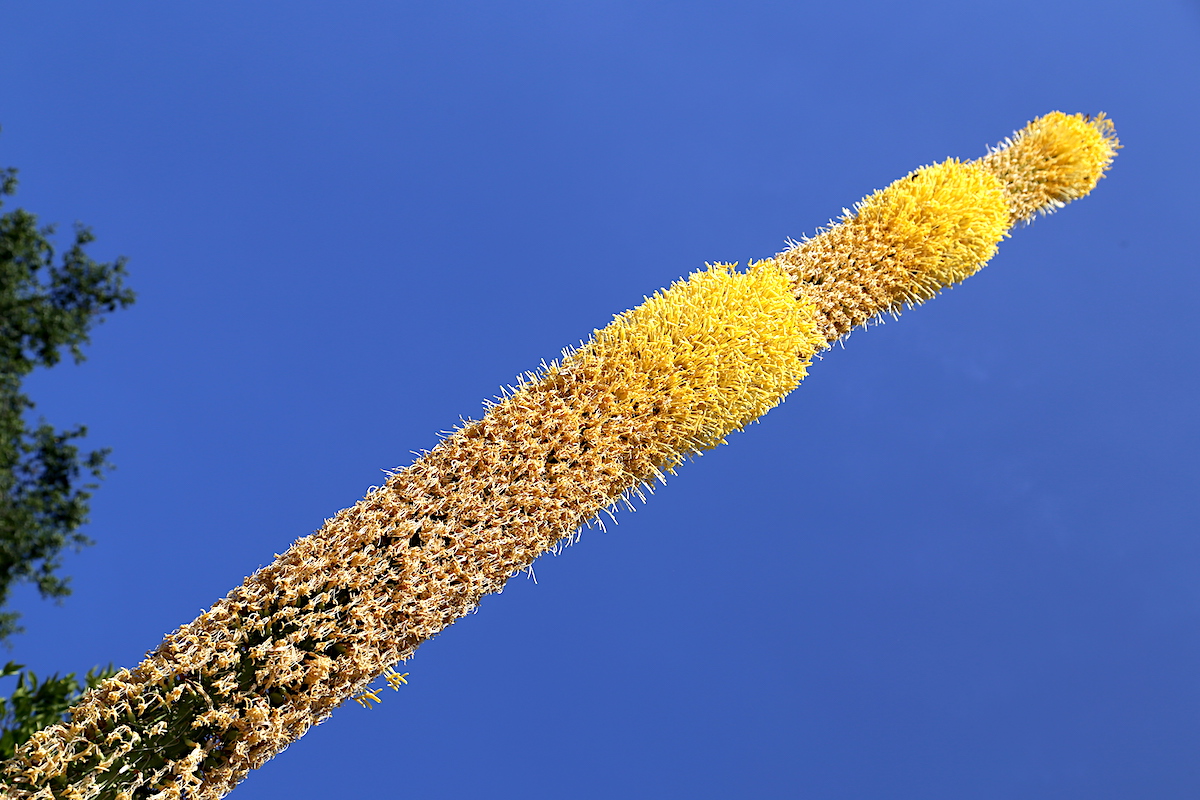
The unbranched bloom spike of Agave vilmoriniana
Flowers' sweet nectar attracts hummingbirds, bees, and other pollinators. Blooms turn into seedpods or bulbils that are clones of the mother plant.

Agave americana seed pods rattle when you shake them.
When a dying mother agave can no longer support its towering stalk, it topples over, propelling seeds or offspring to the ground.
When an agave blooms: Q&A
How do I know what kind of agave I have?
Scroll down to my gallery of agaves in bloom. I've ID'd all for you. To identify your plant before it flowers, find it on my Agave page.
How long until an agave blooms?
Flowering can take an agave years—sometimes decades, depending on the species. Succulent nurseryman and author Jeff Moore says: "Regarding how old they are before they bloom, in our book on agaves we note those that go off relatively quickly, like Agave vilmoriniana and A. desmetiana, but otherwise we just deferred to the 15-25 year average."

Agave desmetiana bulbils
Can I stop an agave from dying?
There’s no stopping an agave from dying after it flowers, so you might as well enjoy the show. However, cutting off the bloom stalk often slows the process, and by doing so you won't have to deal with a tree later on.
How can you tell if an agave is about to bloom?
Leaves in the middle come together like praying hands, as shown in the photo of Agave bovicornuta in the gallery below. These upright leaves surround an emerging bud atop an ever-lengthening stalk.
Are agaves edible? Can I make tequila from mine?
See my article: Want to Make Tequila or Mezcal from Your Agaves? As with most vegetables, roasting an agave enhances its flavor and sweetness. Cottage distilleries in Mexico roast piñas in pits dug into the ground, sort of like a luau... [continue reading]
How to get baby plants?
Wait for the bloom stalk to mature and the mother plant is no longer green, then harvest bulbils or seeds. Start them in nursery flats or small pots until they double in size, then transplant them into larger pots or the garden. In the video, see agave expert Jeremy Spath start seeds.
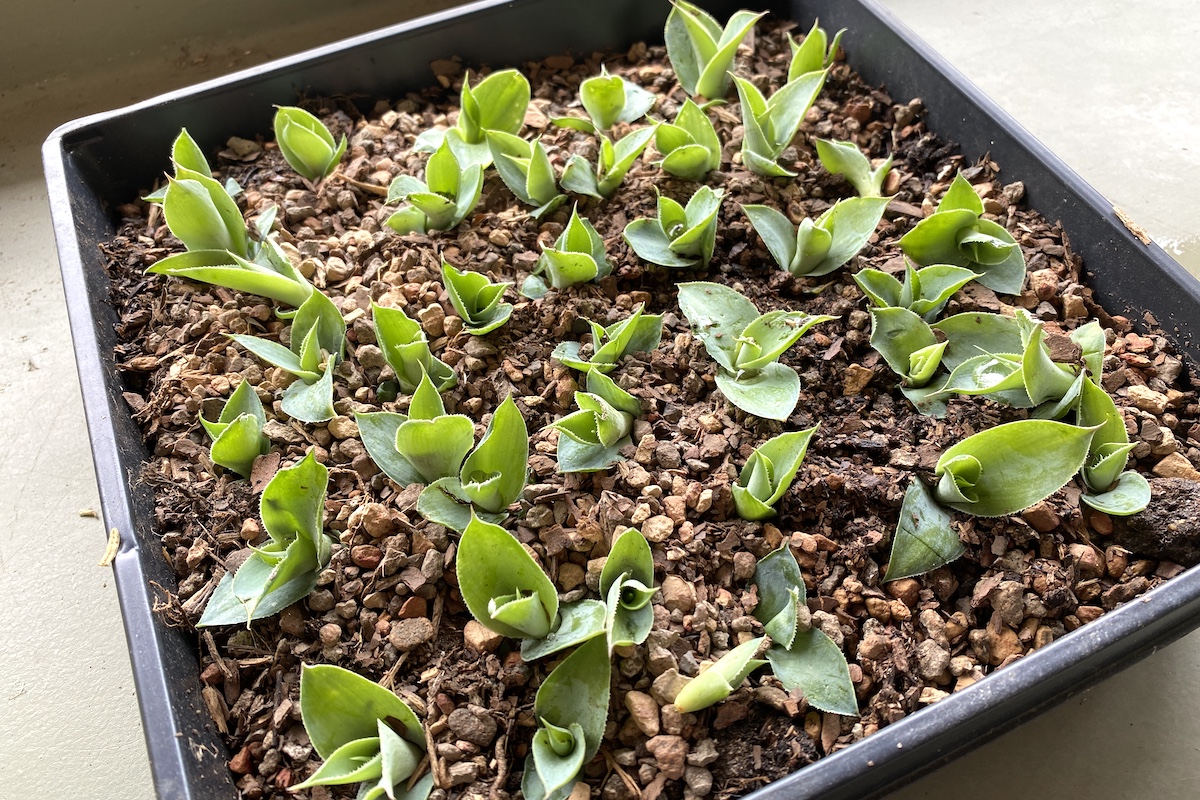
Agave vilmorinana (octopus agave) bulbils
How to remove a big dying or dead agave?
Cut it apart with a saw so all you have is a core that looks like a pineapple. The core is heavy, so let it dry until you can move it. See how professionals removed mine.
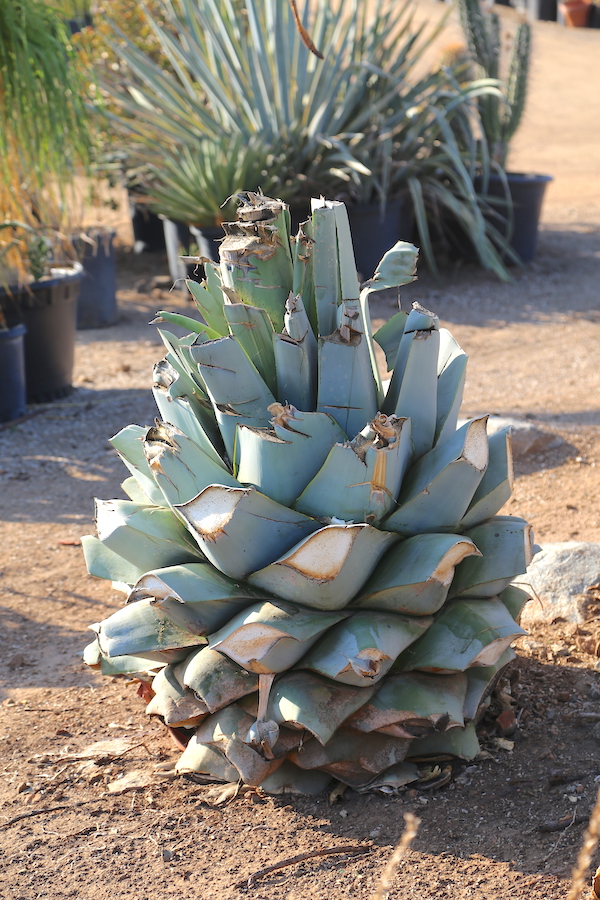
Agave core, pineappled
***CAUTION*** AGAVE SAP CAN CAUSE CONTACT DERMATITIS.
Do a patch test to determine susceptibility. If itching or rash develops, wash the affected area immediately. If symptoms persist, get medical help. USE COMMON SENSE: The drier the agave, the less its moisture content; the fresher the agave, the greater the risk of sap exposure. PROTECT YOUR SKIN: Wear wrap-around eye protection, long sleeves, pants and gloves; cover your hair. Don't wipe your face with your sleeves or other fabric that may have bits of the plant or sap on it. Unless you routinely remove agaves for a living, USE A HAND SAW. A power saw can spray sap.
Gallery of Agaves in Bloom
These photos show 20+ kinds of agaves in various stages of bloom. For the progression, note the months in parenthesis. It's amazing how fast the flower stalks grow! Check back---I'll add more as I run across them.
RELATED INFO ON THIS SITE
Agaves: Uses, Photos, IDs and Varieties
With the exception of a few soft-leaved and variegated varieties, agaves want sun—the more the better in all but desert climates. Most are hardy to the mid- to high-20s F, and some go a lot lower. Sharp points at leaf tips and along leaf edges can make agaves treacherous. I snip about a quarter inch from leaves’ needlelike tips with garden shears.
Agave Dermatitis: How harmful is agave sap? Are you susceptible?
You’re already wary of poison oak, cactus glochids and the milky sap of euphorbias. Add agave sap to the list. In susceptible individuals, it causes the skin condition “agave dermatitis.”
Want to Make Tequila or Mezcal from Your Agaves?
As with most vegetables, roasting an agave’s heart enhances flavor and sweetness. Cottage distilleries in Mexico roast piñas in pits dug into the ground, sort of like a luau.



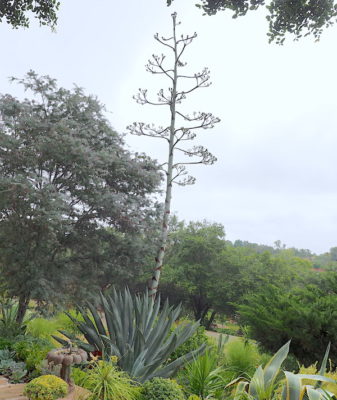

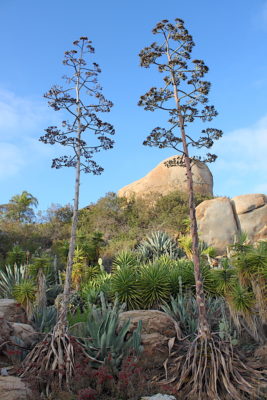
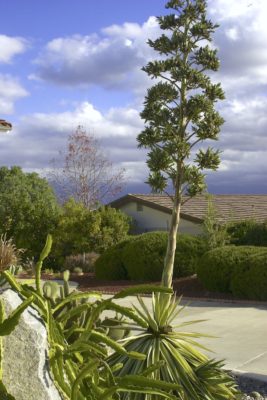
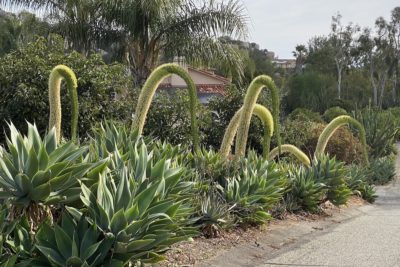




























What a wonderful video. You’re always informative but I just loved the video. The plants looked so beautiful and substantial. I say this with a history of having to eventually remove them too. I will add they make great surfboards; the material is incredibly strong and light weight. Thank you Debra.
PS I loved watching you walk off with the stalk at the end. Debra the Agave Hunter!
Hey Mark! How nice to hear from you! I showed your garden in a Zoom presentation to a CSSA group earlier this week. Thank you for the lovely comment. Yes, I tried to show how lightweight they are, but it was a little heavier than I anticipated. When I lifted it, well, it didn’t lift, so I had to drag it. I do like what that clip adds to the video, though. Cool about the surfboards.
Ok.
Our 20 year old octopus agave bloomed.
It was cool to see the process and all the changes.
But what are we going to do with all these zillions of agave pups?
Thank you for any help.
Hi Mk, I show how I harvest and planted mine in the video. ;+)
I have quite a collection(Americana), some 15 years old, no flowering yet. The multiply like rabbits. Found out about the skin burns by accident, not pleasant but learned my lesson. Pretty easy to dig up when smaller. Large ones (3 feet across) I pulled out with a rope with my car. Seemingly impossible to kill when transplanting.
Hi Corbin — I wish I would have been there when you tied a rope around an americana and to your car’s bumper or tow-bar, ha. Must have been something to see. True…I’ve had excellent luck planting agaves with no roots at all. As long as the center core is intact and healthy, they easily grow new ones.
Finally, you’re the first person to finally say the blooms turn into seed pods. I have been searching all over for that information, thank you so much.
Hi Corbin — Uh…sometimes blooms turn into bulbils, depending on the species. Which is probably why other sources haven’t been helpful. Moreover, it can take years to observe an agave at the end of its flowering, so it helps to have to have a good photo to refer to. One that clearly shows whether those protrusions on the stalk are bulbils or seed pods. Yet they may be 15 feet above the ground! Photos often show either the bloom stalk or the plant, seldom both, and when they do show both, you can’t tell for sure what those thingies are on the branches. As for “what’s a bulbil?” it’s a small (several-inch) clone of the mother plant, with leaves and a bulbous base that’ll nourish it when it falls off and tries to take root.
My agave started to bloom after only 2 years. The Stalk is about 6 ft tall right now. Not sure why so soon the plant itself is still so small.
Hi Randy — I suspect the agave was likely older than 2 years when you obtained it. You mention that the plant is small relative to the size of the stalk…maybe it’s ‘Blue Flame’. They tend to do that. Btw, this program doesn’t allow attachments to comments, but subscribers can send me a photo in response to my newsletter.
I have the same issue and I am unsure what to do. Cut it down or let it alone. It’s not in a very good place.
Why has it bloomed after only being planted 2 yrs. Isn’t this unusual
Hi Barbara (and Randy), it does seem premature, but certain species are early bloomers (notably Agaves desmettiana and A. vilmoriniana). How old the plant was when you got it makes a difference. Its biological clock doesn’t start ticking when it’s planted. If it’s not in a very good place, sounds like more of an opportunity than a problem! DLB
My agave parryi bloom stalk (approx 15′ tall) snapped off in a gust of wind. The flowers on the stalk have not yet opened. If I plant the stalk in the ground or put it in water will the flowers bloom? Or am I sadly just out of luck?
Hi Susan — Putting it in soil wouldn’t help because a bloom stalk won’t form roots, but it likely can take up water. However if it’ll get enough water over enough time to finish blooming is anyone’s guess. And even if it does bloom, it still has to be pollinated (by bats that maybe aren’t indigenous to your area and elevation), and form seeds that sprout. So many variables…why not simply propagate it from offsets? Btw, a bonus to it breaking off, especially if it happened close to the plant, is that the main bloom stalk may be replaced by smaller ones.
Es interesante su contenido me ha parecido muy bien ya que tenemos un modesto vivero el cual la información que usted posee en su página web me ha ayudado a identificar algunas plantas, saludos desde la “Coordinación del Parque Nacional Ciénagas de Juan Manuel – Vivero El Solar”, Encontrados, Estado Zulia Venezuela🇻🇪. GP Darwinso Álvarez
Hola Darwinso, Me complace saber de usted y le deseo a usted y a su vivero de plantas un gran éxito. Gracias por sus amables comentarios. ¡Me alegro de que mi sitio web te haya resultado útil!
Your recent post “What to Do When Your Agave Blooms” arrived just at the right time. We have several Blue Glow Agaves which have been the pride and joy of our landscape for years. Unfortunately two plants which are a focal point in one area have started bloom stalks. Although your video clearly states that new plants come from the stalk, on the sides of our plants there appear to be what look like pups. We were wondering if these might possibly be viable new plants. Fingers crossed; hope springs eternal.
Hi Rosemary — What likely happened is that the meristem tissue (which produces new growth, leaves and roots) went kinda crazy due to being stimulated by blooming. Any offsets should be viable. I’ve seen rare agaves in collections that the owner had deliberately “cored” to create baby plants. Nurserymen do this because it takes agaves so long to bloom, so coring is a much faster way to propagate them.
If you cut above and below the offset, leaving a bit of stem to anchor it, you’ll likely have success growing it. Its bottom leaves just need to touch the soil. Start it in a nursery pot filled with “cactus mix” soil and keep it out of intense sun until well rooted. Then it can go in the garden like any nursery-grown plant. I’ve done that with mangaves, which are closely related to agaves, and which offset from the center after blooming.
Something else to know about ‘Blue Glow’ is that it’s a cultivar of two Agave species, and it’s not the only one. Its siblings have different traits. If yours came from Waterwise Botanicals, it might be ‘Moonshine’ — see them both on my site. ‘Moonshine’ is known for offsetting, whereas ‘Blue Glow’ isn’t. But there are exceptions, and in any case, blooming is a different situation from the “usual” way agaves pup from their roots.
Hi, all agave species die after blooming?
No. But most do. I’ve heard that Agave bracteosa survives blooming, but mine have never bloomed, so I can’t speak from experience. Also according to the Ruth Bancroft Garden, “in cultivation Agave geminiflora may sprout new shoots from among the leaves after it has flowered, forming a clump.” That’s what my mangaves do. The main rosette may die, but new ones form.
Hi Debra,
We moved to Kingman, AZ and we have a A. Parri that is our crown jewel in the backyard. In the last year we have had three blooms that progressed in size. Now it is growing a central spike. Is it common to have two different kind of blooms? Would love to send you a picture.
Norm
Hi Norm — My site doesn’t allow photos attached to emails, but subscribers to my newsletter can click “reply” and send emails with photos. Re your Agave parryi, yes, sometimes multiple blooms happen. Typically it’s when the plant’s reproductive hormones go into overdrive, often stimulated at the meristem tissue at the core of the plant. This can happen when there’s some damage to those tissues, most often from the bloom stalk being severed at the base. It’s a pity that your crown jewel won’t survive its reproductive destiny…but perhaps it will leave you pups?
thank you for the article
Wonderful video on Agave. I recently saw an Agave Whale’s Tongue in bloom at the Savannah Coastal Botanical Garden. Such a site to behold. Only one question before I try growing agave. I live on a Coastal SC island with an over population of deer. Will the deer eat them?
Laura
Hi Laura — I’m glad you enjoyed the video! Re growing agaves in your region, it’s challenging due to the humidity (they’re native to arid regions and tend to get fungal diseases and rot given too much moisture). But if you saw Whale’s Tongue thriving at a nearby botanic garden, that’s certainly encouraging, and it IS a beautiful plant. As for deer, I’ve seen deer damage to the species Agave attenuata—shredded leaves—but not others. That one is soft-leaved. Which is not to say deer wouldn’t eat other agaves. Deer are infamous for eating anything if they get hungry enough. And you do say your island has an “overpopulation.” Might be worth trying, though. Throw chicken wire or hardware cloth over the agave while it’s young and tender, to give it a fighting chance.
Hello! Two of my 3 agave vilmorinianas bloomed this spring and now the babies are growing happily along the stem. I have two questions. First, do you think nurseries would be interested in any of the babies? Is that a weird thing to call them about? I have no desire to try and pot up alllllllll of the hundreds of babies and thought if I could chop up the stalk into sections I could give them to the nurseries for them to pot up? I hate to think about them just being thrown out! Second, how in the world do I cut down such a large and heavy spike? If it falls in the direction of the house it will no doubt do some damage since it is basically a tree at this point. It is probably between 15-20 ft. tall! Thanks so much for all of your wonderful content!
Hello thanks for your agave collection! Blue agave pictures are wrong, if you need one let me send you. Best wishes, Ana
Hello. I have what I think is an Agave celssi Nova about 4 years planted in ground which is putting out a flower spike about 2 to 3 feet tall now. Can I cut off the spike now to prevent plant from dying? I have another one that bloomed and died last year and has yet to be dug up.
Hi Francine — It’s not possible to prevent an agave from dying by cutting off the bloom spike, but doing so can slow it down. It may produce smaller, auxiliary flower spikes which you can keep if you find them ornamental, or remove.
Regards,
Debra Lee Baldwin
Hallo, ik heb een agave attenauta met een bloemenstengel van ongeveer. 64 cm. Momenteel staat hij in een onverwarmde veranda. Kan hij daar overwinteren ?
Hi Debra, thank you for your wonderful video. I wish I watched it earlier. Our Victoriae Reginae recently flowered. I am worried that the stalk has been cut off too early to get seeds. All of the external flowers are spent however, they see bulbs are still green and fleshy. Is there any hope of the seeds being recovered now?
Hi Nadia — It doesn’t seem likely, since the flowers are spent. But this species can be propagated by bulbils as well. It sounds like they’re mature enough to be worth a try.
What an informative video. My largest agave in my yard has just begun to bloom. I hate that it will die but am excited to see what the flowers look like. It has several pups that I haven’t been able to get to, mainly for fear of damaging the mother plant. Living in Florida, succulents are the best bet for beauty and low maintenance. Thanks for sharing your experience.
Thank you, Karen — I’m glad you found it helpful! Yes, you’ll see a flowering event that is infrequent and unforgettable. And when you get rid of Mom, you’ll have pups to replace her!
Well I bought what I thought was an ornamental plant at Lowe’s years ago and it turned out to be an agave which is just starting to bloom. I wish I had of known because it’s inside my pool cage. Height isn’t an issue but bummed that the hummingbirds and bees are going to miss out. I really can’t tell what variety it is. By the way I’m 8n Florida where it rains and is humid in summer so kinda surprised at this thing. Thanks for the article. Any suggestion on how to identify it.
Hi Mike — It’s probably Agave americana (century plant), which is better able to handle summer heat and humidity than most agaves. Or possibly Agave attenuata (fox tail agave). Find photos of those and other candidates in the Agave gallery here on my site.